Monstera adansonii is the second most popular Monstera after Monstera deliciosa, its larger cousin. We are going to tell you more about Monstera adansonii narrow and wide forms and varieties or subspecies.
That is not all. We also have everything you need to know on Monstera adansonii care like soil, watering, light, pruning, repotting, temperature, and so on. If you need details, we have a separate post on care. It will expound everything.
Last but not least, since we have covered them elsewhere, we don't intend to go deep into propagation or the variegated form.
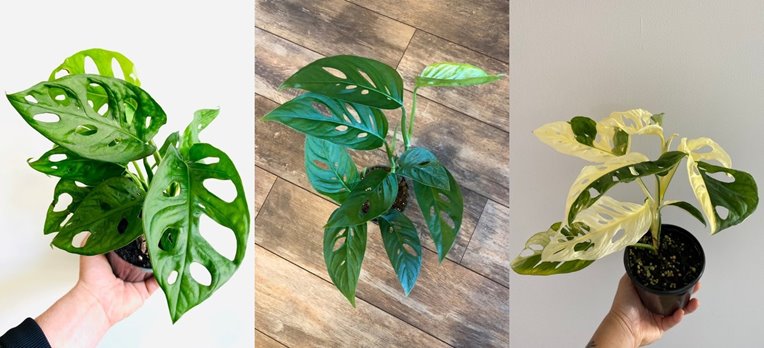
Contents
- About this Monstera
- Quick overview
- Identification – appearance and description
- 1. Growing habits
- 2. Size
- 3. Juvenile and mature leaves
- 4. Stems
- 5. Monstera adansonii flower
- Monstera adansonii narrow form, wide form, and variegated
- 1. Monstera adansonii narrow form
- 2. Monstera adansonii wide form
- 3. Variegated Monstera adansonii
- Monstera adansonii varieties
- 1. Monstera adansonii var. laniata syn. Monstera friedrichsthalii
- 2. M. adansonii var. adansonii
- 3. M. adansonii var. klotzschiana
- 4. M. adansonii subsp. blanchetii
- Monstera lechleriana vs. adansonii
- Monstera acacoyaguensis vs. adansonii
- Where to grow them
- Monstera adansonii care and growth requirement
- 1. USDA hardiness zone
- 2. Temperature
- 3. Humidity
- 4. Monstera adansonii light requirements
- 5. Best Monstera adansonii soil
- 6. Monstera adansonii watering
- i. Overwatered
- ii. Underwatered
- 7. Fertilizer
- 8. Pruning and grooming
- Repotting
- Propagating Monstera adansonii
- Toxic to pets and humans
- Pests
- Diseases and conditions
- 1. Monstera adansonii yellow leaves
- 2. Leaves curling
- 3. Drooping leaves
- 4. Leaves turning brown
- Frequently asked questions
About this Monstera
Monstera adansonii, also known as Adanson’s Monstera, Swiss cheese plant or vine, five-hole plant, is a popular houseplant.
We bet you love its eye-catching heart-shaped to oval to juvenile glossy leaves that may have or miss holes and the large, adult, perforated leaves. Also, this vining plant is easy to care for and it is air purifying.
For newbies, Monstera adansonii is a complex species with many forms or clones. It belongs to the arum family Araceae, the so-called aroids. And it is one of the widely occurring and most abundant Monstera in mainly Central and tropical South America. But it doesn’t occur in nearby islands.
In Sweden, Germany, Poland, New Zealand, Italy, Israel, France, and Denmark, some vendors label Monstera adansonii as Monkey Mask monstera. Even in the US and the United Kingdom, you will find the name Monkey Mask monstera. It is the same plant.
Last but not least, the name ‘Swiss cheese’ comes from having leaves with holes that resemble Swiss cheese. It shares the name with Monstera deliciosa and the rare and highly perforated Monstera obliqua. Also, some people cause it Cheese Swiss philodendron. But it is not a philodendron.
Quick overview
| Scientific name | Monstera adansonii |
| Family | Araceae |
| Common names | Its common names are Adanson’s Monstera, Swiss cheese plant or vine, five-hole plant, Monkey Mask monstera or Cheese Swiss philodendron |
| Native habitat | South and Central America and surrounding islands |
| Type | Evergreen, tropical climbing hemiepiphyte |
| Growth rate | Medium |
| Size | 6.5 to 20 feet (2-6m) in the wild and 4 to 8 feet inside the house |
| Leaves | It has heart-shaped to oval to elliptical juvenile glossy leaves that may be equal or unequal and have a few holes. Large mature leaves with perforations. Also, they can be symmetrical or asymmetrical. |
| Flowers | It has small, inflorescence flowers borne on a spadix surrounded by a spathe. Colors vary from one variety to another. |
| Blooming time | All year once this plant matures |
| Care level | Low or easy |
| USDA hardiness zone | 11b to 12 |
| Light requirement | Bright, indirect light |
| Temperature | 65°F to 80°F (18 to 27 ºC) |
| Humidity | Prefers high humidity 60% or more can it tolerate lower |
| Best soil | Chunky, well-drained, and aerated soils or potting mixes rich in organic matter |
| Watering | Medium, after the top 2 to 3 inches of the soil dries |
| Repotting | Repot after every other year |
| Propagation | Stem cutting |
| Toxicity | Toxic to humans and pets |
Identification – appearance and description
Let us now look at an overview of this Monstera. Here we will describe its appearance (how it looks like) and growing habits. Later, we will look at the four subspecies, giving you specific descriptions to help tell the difference between each.
Remember, as a complex species, the growing habits, leaves, and flowers may differ from one variety to another.
1. Growing habits
Like others, this Monstera is an evergreen climbing hemiepiphyte. As a juvenile plant, it will creep on the ground. But if it gets a place to climb, it will mature and break its link to the ground.
It is the most widespread Monstera found in many countries in the tropical South and Central America, mainly in warm and humid rainforests. You will find it growing on tall rainforest tree trunks, sheltered by their canopies. But it also has weedy tendencies and will grow on telephone and fence posts.
Last but not least, Monstera adansonii is a vigorous grower in an ideal growing environment. It has a medium growth rate, able to increase by 1 to 2 feet per year.
2. Size
In the wild, M. adansonii grows from between 6.5 to 20 feet (2-6m) long, but it will, in most cases, reach 6.5 to 13 feet (2-4 m) long. At home, expect it to be about 4 to 8 feet long and 1 to 3 feet wide. But if you grow it outside, it may become a little longer.
3. Juvenile and mature leaves
This Monstera has entire oval to elliptical juvenile green leaves. But some may be unequal and falcate. These leaves get holes (fenestrations) at very early stages when they are barely 2 to 4 inches long.
On the other hand, M. adansonii mature leaves are sub-leathery, glossy, and oval to elliptical, with some being very asymmetrical. The leaf blade measure 10 to 28 inches long, 6 to 18 inches wide. Also, these leaves will have an entire margin and zero to many perforations that occur in one or two series. So, it is normal for Monstera adansonii to have no holes.
Their leaf base may be broadly truncate or cuneate. But some will have an unequal or oblique base with one side cuneate and the other nearly heart-shaped to truncate.
Last but not least, both juvenile and adult leaves have a vaginated petiole whose sheath wings may persist or fall (dry and drop)
4. Stems
Both the juvenile and adult stems are green. The juveniles have thinner terete stems with shorter internodes. On the other hand, adult plants have a bit thicker, subterete stems with slightly longer internodes and leaf scars.
Also, the stems have aerial roots, which help the plant anchor to a climbing surface. Also, they absorb nutrients and moisture from the air and surrounding.
5. Monstera adansonii flower
Monstera adansonii has small inflorescence flowers borne on a spadix. This spadix may be cream to yellow, whitish-cream, or pale to medium yellow to orange. Also, these flowers have a spathe - a leaf-like structure that surrounds the spadix. It may be pale-yellow, cream or whitish-cream with a green tinge.
The fruiting spadix will turn greenish and eventually yellow to deep yellow when the fruits mature. These fruits have a graying pulp and mostly a single, oblong black or gray seed.
Monstera adansonii narrow form, wide form, and variegated
Monstera adansonii narrow and wide forms are the most common forms in the market. However, some vendors have a variegated form. Let us look at each of these forms.
1. Monstera adansonii narrow form
Monstera adansonii narrow form has elongated, unequal narrower leaves. The leaf blade length is more than twice the width, and the leaf’s tip points to one side. Also, these leaves are unequal, i.e., one side is larger than the other. Just look at their base, and you will notice it more clearly.
The other feature of M. adansonii narrow form is that it has fewer, smaller and narrower holes. Also, these leaves are less ruffled.
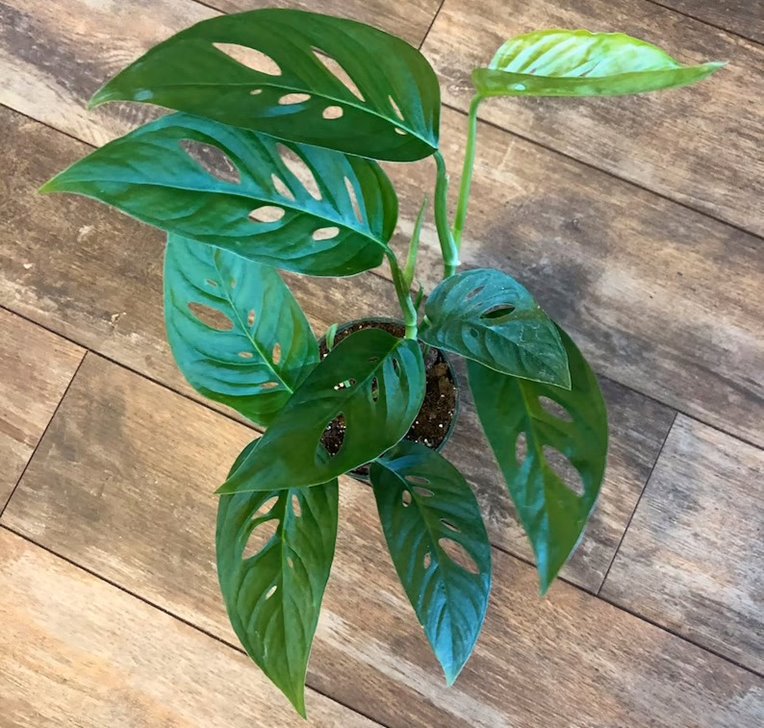
It is not clear if the narrow form is a clone or one of the subspecies. If it is a subspecies, then it would be M. adansonii var. adansonii. This is only a wild guess. Some people think otherwise.
2. Monstera adansonii wide form
Monstera adansonii wide form has more heart-shaped or broader and larger leaves. Their exact shape may slightly vary, with some having a more roundish appearance and others a little elongated. But the leaf length is in most cases less than twice the width.
That is not all. The leaves appear more symmetrical or equal (not 100%), and the holes are larger and more in number. These holes may be roundish or elliptical but not so elongated as the narrow form.
Last but not least, M. adansonii wide form has more ruffled and glossy-looking leaves. But they are not so much crinkled.
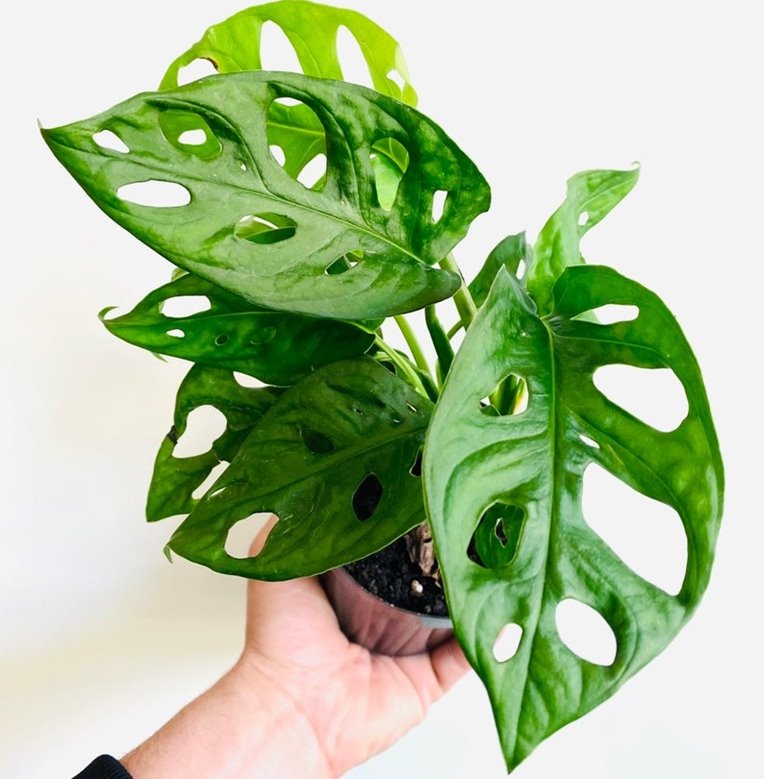
3. Variegated Monstera adansonii
The variegated M. adansonii is a rare and costly form. It has green leaves with mainly cream to whitish variegation, with some having yellowish markings and mint leaves.
The common one is Monstera adansonii Archipelago. But there are many others like Monstera adansonii variegated Albo Japanese Tricolor, Half Moon leaf, mint variegated, Mint Variegated 2 Leaf Indonesia Variegated Form, etc. See more M. adansonii variegata for care, propagation, prices, and where to buy.
When buying the variegated forms, be careful and go to trusted vendors. Some people may con you. Also, seeds cannot give you a variegated plant. We recommend Etsy.com for the best prices. However, eBay is also a good place.
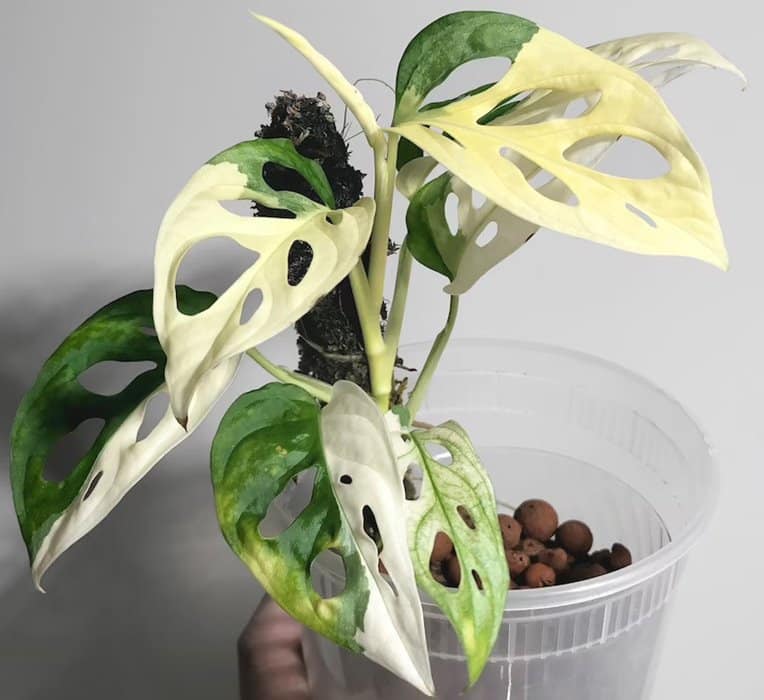
Monstera adansonii varieties
There are four Monstera adansonii varieties, i.e., M. adansonii var. laniata, M. adansonii var. adansonii, M. adansonii var. klotzschiana, and M. adansonii subsp. blanchetii.
These varieties look different morphologically and in their geographical distribution. But when they occur in the same place simultaneously, they will hybridize freely, making it difficult to distinguish them.
Let us look at each of these species. But please don’t confuse these varieties with the normal, narrow, or wide forms or clones.
1. Monstera adansonii var. laniata syn. Monstera friedrichsthalii
Monstera adansonii var. laniata occurs from Peru to Nicaragua, French Guiana to Venezuela, northern Brazil, and Southern Mexico.
The leaf base is very unequal, i.e., it may truncate on one side, and the other may be cuneate to acute. Also, its petiole sheath wings don’t persist (they dry and fall off). And on one side, the lateral veins will arise at an angle more than 60 degrees.
When young, the oval juvenile leaves are 1.5 to 2 times longer than the width and may have 1 to 4 elliptical holes on either side.
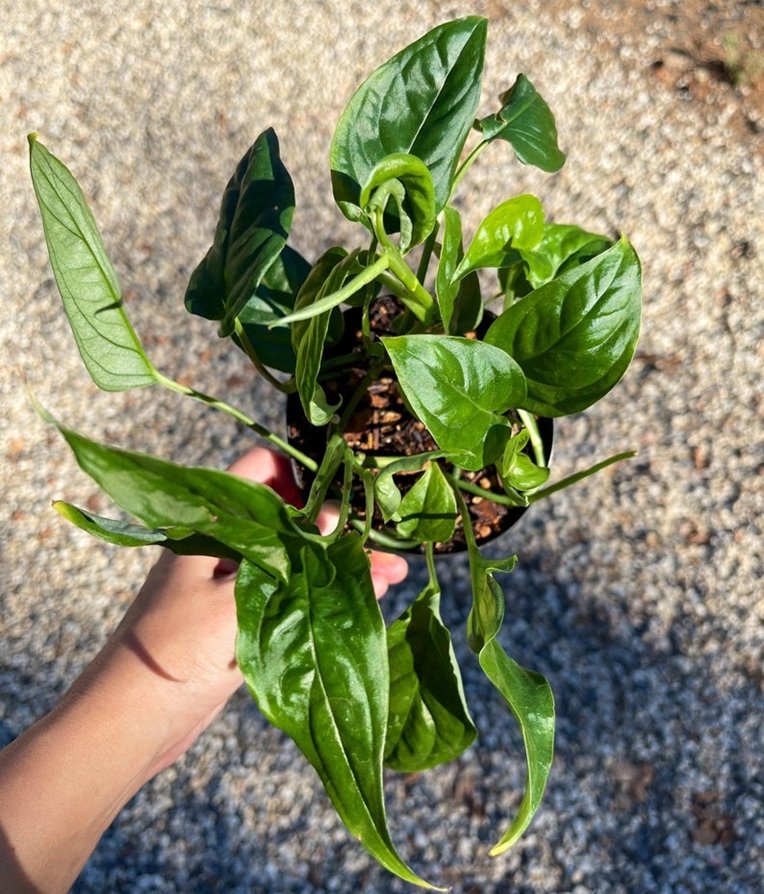
As the plant matures, the leaves become more prominent and oval to broadly oval with lengths less than twice the width. Also, they will have several series of elliptic to elongated holes that are more petite than the other varieties. However, they may at times not have any holes.
Last but not least, the spathe is cream to pale yellow and 1.5 to 2 times longer than the flowering spadix, which is pale yellow.
2. M. adansonii var. adansonii
M. adansonii subsp. adansonii is native to Trinidad-Tobago, Netherlands Antilles, Leeward, and Windward islands. But it was also introduced in Puerto Rica.
The petiole sheath wing persists (don’t dry up and drop), and it has falcate juvenile leaves with the leaf blade about 3-4 times longer than wide.
On the other hand, the mature leaf lamina is oval to elliptical with lengths more than twice the width. Also, these leaves have 1 to 5 oval to elliptical holes on either side. The lateral veins arise at angles mostly less than 60 degrees on both sides. And the base is unequal and may be bluntly acute to cuneate.
Lastly, it has a pale-yellow spathe whose length is two times or more than the spadix, and the flowering spadix is cream to pale yellow.
3. M. adansonii var. klotzschiana
Monstera adansonii subsp. klotzschiana naturally grows in Brazil, Bolivia, French Guyana, Guiana, Suriname, and Venezuela.
Juvenile leaves are oval to elliptical and measure 2 to 4 times longer than width. They are primarily entire but may rarely have one or two holes on either side of the leaf blade.
On the other hand, mature leaves are about twice as long as broad. The primary lateral veins arise at angles less than 60 degrees. Also, these leaves have 1 to 8 ovals to narrowly elliptical holes on either side of the midrib.
Last but not least, the fruiting and flowering spadix is pale to medium yellow to orange. The color of flowers will help you know this variety. The others have cream to pale yellow flowers.
4. M. adansonii subsp. blanchetii
Monstera adansonii var. blanchetii is another accepted variety native to southeast and northeast Brazil. It has highly asymmetrical leaf blades and more holes than var. klotzschiana.
Juvenile leaves may be narrow to broadly oval, unequal, and mostly falcate. The base is acute to subacute on the thin side and rounded to nearly heart-shaped (subcordate) on the broader side. Also, they have no or up to 6 elliptical holes.
On the other hand, mature leaves are equal to very unequal, not falcate to very falcate. Also, they have a subacute, rounded to truncate base on the narrower side and emarginate or subcordate (nearly heart-shaped) on the broader side.
That is not all. Mature leaves have about 15 to 33 perforations that may be oval, elliptic, or very elongated. These holes occur in one or two series on either side of the leaf blade. Sometimes, the perforations run from near the mid-rib to near the margin leaf.
Last but not least, these subspecies flowers are on a whitish-cream spadix and have a whitish-cream spathe with a green tinge.
Monstera lechleriana vs. adansonii
To quickly tell the difference between these two, look at how the leaves appear, internodes, and where they occur in the wild.
Monstera lechleriana occurs in higher altitudes and grows below branches in larger tree trunks. It has leaves borne on a tight cluster of 10-15 leaves at the top of the stem. Also, it has shorter internodes, and petiole bases overlap, hiding the stem. The other difference is that this Monstera tends to have more and larger holes.
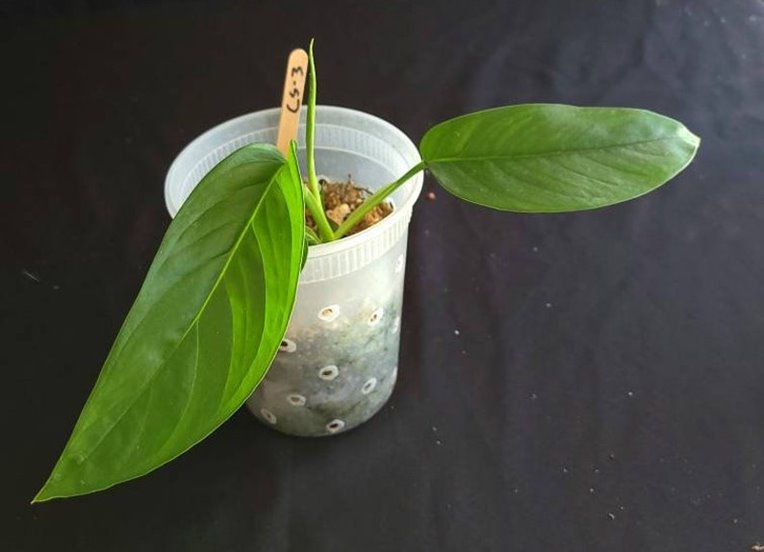
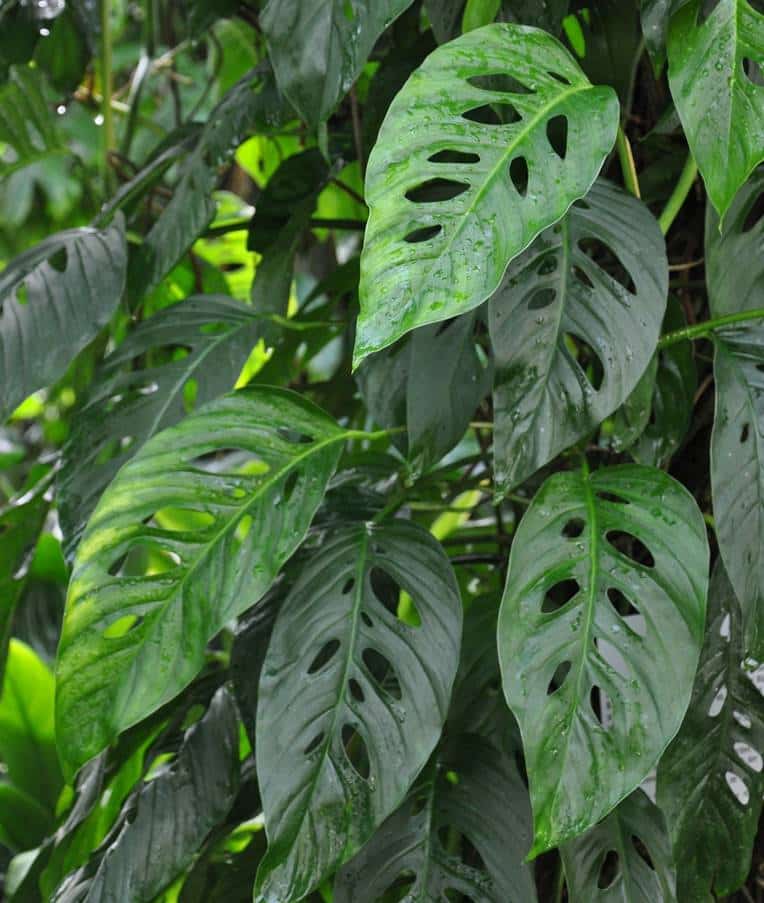
On the other hand, the adansonii doesn’t have leaves borne on a tight cluster. The internodes are slightly longer and occur at lower altitudes. Also, they have fewer, smaller holes, not in several series.
Monstera acacoyaguensis vs. adansonii
If you have both mature plants with flowers, you can easily separate adansonii from Monstera acacoyaguensis. The M. acacoyaguensis flower stalk or peduncle, spathe, or spadix are longer.

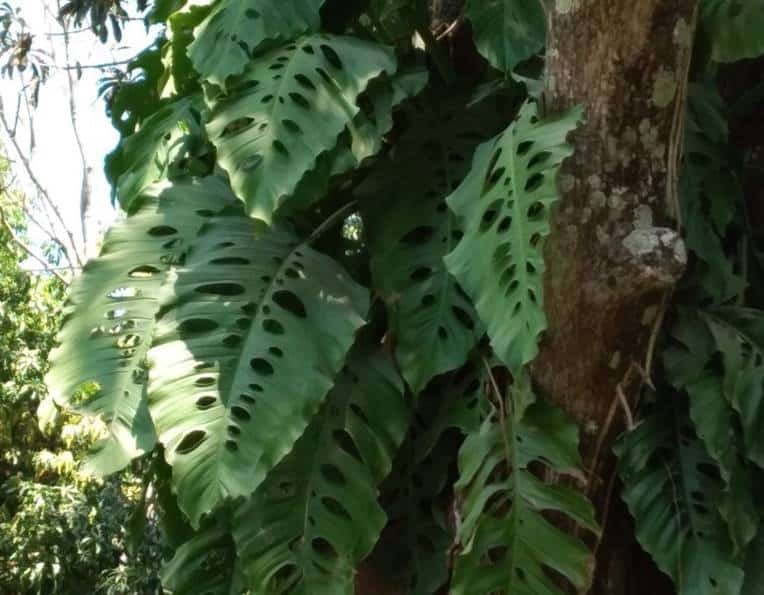
Where to grow them
You can grow it, including any of the varieties and forms indoors or outdoors. But you first need to make sure you meet the various growth requirements.
If you want large perforated leaves, we recommend you give stake or give it somewhere to climb. You can go for a burlap-wrapped or moss pole. Even the trellis, bamboo poles, or any climbing surface will work.
While it is crucial, a climbing place isn’t a must. Some people love to let these plants cascade from hanging baskets or draping over tables, windowsills, cabinets, and so on.
Monstera adansonii care and growth requirement
It is easy to care for this ornamental plant. You need to ensure it has bright, indirect light, above high humidity, and warm conditions. But don’t forget to have suitable soil and water them appropriately.
We have something exclusive on Monstera adansonii care, including watering, best soil, light, humidity, and so on. Thus, we are going to summarize care needs and requirements in this post.
1. USDA hardiness zone
This Monstera’sUSDA hardiness zone is 10b to 12. These plants cannot tolerate frost. Also, freezing temperatures will kill them. If you are in these zones, you are free to grow this plant outdoor throughout the year.
2. Temperature
The ideal temperature for this Monstera is 60 to 80 degrees Fahrenheit (15 to 27°C). Colder places will slow growth, and at 50°F (10°C), this plant will stop growing. Also, avoid cold drafts, sudden drips or spikes, or areas with very high temperatures like near furnace, radiator, room heating systems vents, etc.
3. Humidity
This Monstera needs above-average humidity, 60% or more, for sheen and lush leaves. But it can stand slightly lower, 40ish to 50ish. If your home has low humidity, mist it a few times a week or have a pebble tray.
Also you can put your plants together or move them to a room with higher humidity. A kitchen and bathroom are terrific such places.
However, if your humidity is low, buy a humidifier. AquaOasis™ Cool Mist Humidifier (Amazon's best-seller) is an excellent pick. It is affordable, runs for up to 24 hours and quiet.
4. Monstera adansonii light requirements
Monstera adansonii requires bright, indirect light. Low light will make this plant leggy and grow slowly, with the variegated Monstera adansonii most affected. If you can’t meet these light needs, get grow lights.
On the other hand, avoid direct sunlight (it will scorch the leaves). Any window (east, west, south, or north-facing is ok. Just ensure no direct sunlight hits your plant, especially on the hot afternoon. Outside, use shade cloth, have a greenhouse, or grow it under a shade.
5. Best Monstera adansonii soil
The best Monstera adansonii soil should be well-drained, aerated, and rich in organic matter. Also, it needs to hold moisture without being soggy and should be slightly acidic to neutral; pH 5.5 to 7.5 are ok.
An aroid mix (see Etsy.com ) or a homemade chunky potting mix with houseplant potting soil, perlite or pumice, and peat moss or coco coir will work. Avoid heavy, poorly drained or soils that cannot hold moisture.
6. Monstera adansonii watering
They require medium watering. So, please, water your Monstera adansonii when the top 2 to 3 inches of the soil is dry. Alternatively, you can let the top 50 to 75% of the soil dry first.
We highly recommend that you first feel the potting mix with your finger. Forget about those that tell you how often to water to Monstera adansonii, like once or twice a week. This depends on temperature, humidity, light, soil, etc.
You can use your finger to test your potting mix. If it feels dry up to the first knuckle, water your plant.
Alternatively, use a soil moisture meter or sensor. We use XLUX Soil Moisture Meter and water when the reading is in the dry zone, i.e., three or less.
Finally, to water, slowly saturate the soil until water comes from drainage holes. Then discard any water that collects on the saucer. If you want more details, see how often to water monstera.
i. Overwatered
If the soil is always soggy and the leaves are turning yellow, you are overwatering your Monstera. Also, the leaves may turn brown, curl, wilt, and so on.
ii. Underwatered
When thirsty, your Monstera leaves will start curling up or droop, and the soil will feel dry. Also, they may have crispy brown tips and edges. If ignored, expect leaves to fall, slow growth, and even death.
7. Fertilizer
They need medium feeding. Use balanced, all-purpose, liquid plant food and apply it once a month during growing months only or as recommended by manufacturer.
If you want a balanced formula, go for Miracle-Gro Indoor Plant Food (Liquid) NPK 1-1-1. A pump is enough for a small pot and two for larger (more than 6 inches in diameter). Apply once every two weeks.
Osmocote Smart-Release Plant Food Plus Outdoor & Indoor is a great choice for a slow-release formula. You will use it once every four months. Follow application instructions.
8. Pruning and grooming
Cut any dead, diseased, damaged leaves with a sterilized pruning shear or knife. Also, wipe the leaves if they become dusty with a damp, soft cloth.
You can trim off a few branches in early spring or even summer to control its growth and shape. Also, it will encourage a fuller plant.
Repotting
It requires repotting after every other year, or if it is rootbound – you will see roots growing from drainage holes.
Pick a pot 2 to 3 inches wider in diameter. Also, repot it in early spring. But summer is ok. Also, please don’t forget to clip any brown or black roots with sterilized pruning scissors.
Propagating Monstera adansonii
The best way to propagate Monstera adansonii is by stem cutting either in soil or water. But you can also go for air layering or seeds. Seeds are rare but available. However, seeds will not work for the variegated form.
Wait until early spring to propagate your plant. Summer is also ok but may not give your plant enough time to root. If you need steps, and much more, see M. adansonii propagation in soil and water.
Toxic to pets and humans
Monstera adansonii is toxic or harmful to humans, cats, dogs, and other pets. It will cause severe mouth irritation and a burning feeling, and your mouth, tongue, or lips may swell if chewed. Other signs are drooling, swallowing difficulties, loss of appetite, and your pets may paw their mouth.
Pests
If you grow this Monstera indoors and always isolate new plants, it is unlikely to have pests. That said, it doesn’t mean they are immune. These plants can end up with scale insects, whiteflies, spider mites, thrip, or aphids.
Always check for any of these bugs and manage them. How to go about it depends on which one you have.
Diseases and conditions
This Monstera can have the mosaic virus, root rot, rust, southern blight, leaf spot, botrytis, or anthracnose. But root rot is the most likely issue you will have, and it happens due to mainly overwatering.
Let us look at some conditions that this plant may have:
1. Monstera adansonii yellow leaves
The most likely cause of yellow leaves is overwatering. To confirm this cause, check if the soil is also soggy or wet.
The other possible reasons for the yellowing of leaves are underwatering, low humidity, cold drafts, nutritional deficiencies, and too much heat. Also, it may be transplant shock, too much fertilizer, pests, diseases, or your plant is rootbound.
If you Monstera has yellow spots on leaves, it is likely a leaf disease, pests, deficiency of some nutrients, or anything that causes leaf burn. Look at the other signs your plant has.
2. Leaves curling
The number one cause of Monstera leaves curling is underwatering. If thirsty, your plant will have dry soil. But it can be anything that has to do with more losing moisture than roots can absorb. Here, issues like too much heat or light, overwatering, low humidity, or being rootbound come to play.
Also, sap-sucking pests, deficiency of some nutrients, disease, plant shock may be behind the curling or wilting.
3. Drooping leaves
The reasons why these Monstera leaves are drooping are similar to those that cause curling leaves.
As it is with curling, the most common cause is underwatering. Others are low humidity, heat stress, overwatering, too much light and cold drafts. Also, it may be diseases, pests, plant shock, or being rootbound.
4. Leaves turning brown
If your plant leaves have crispy, brown edges, tips, and sometimes spots, it may be underwatering, low humidity, too much sunlight, fertilizer burns, or your plant is rootbound.
Brown splotches may also be an issue with overwatering, especially when root rot has set in, while the whole leaf turning is a sign of cold drafts.
Last but not least, brown spots may also show up due to pests and some diseases. Look at other signs to help tell what is ailing your plants.
Frequently asked questions
No. M. adansonii, including the narrow and wide forms, are not rare. You will find them in your local nurseries, and some big box nurseries have them. But the variegated form is rare and costly.
Monstera adansonii price ranges from $10 to $50 or more for rooted and established plants. Unrooted cuttings may cost less, i.e., below $10. How much you buy it depends on where you buy it and your location. You don’t expect the prices in Australia, Canada, the US, or the UK to be the same.
However, if you want the variegated form, it costs much higher, with typical prices ranging from $300 to $3000 depending on which one and plant size.
The best place to buy Monstera adansonii is Etsy.com. But you can start by looking at the local nurseries. Other places to buy include Amazon, eBay, Bloomscape, the Sill, Logees.com, Planterina, among other sites. Also, try Facebook plant group, Instagram, Craigslist, etc.
Are your Monstera new leaves not unfurling? Check if you have adequate humidity, light and your plant is well-watered. If all these are optimum, be patient. New leaves take a while to unfurl.
Your M. adansonii has no holes? Don’t worry and be patient. It is most likely that it is still a very young plant. They don’t get perforations at this age, but it is also typical for this plant not to get the holes.
Also, you need to ensure it has enough humidity, water, light, and a climbing place.





Leave a Reply